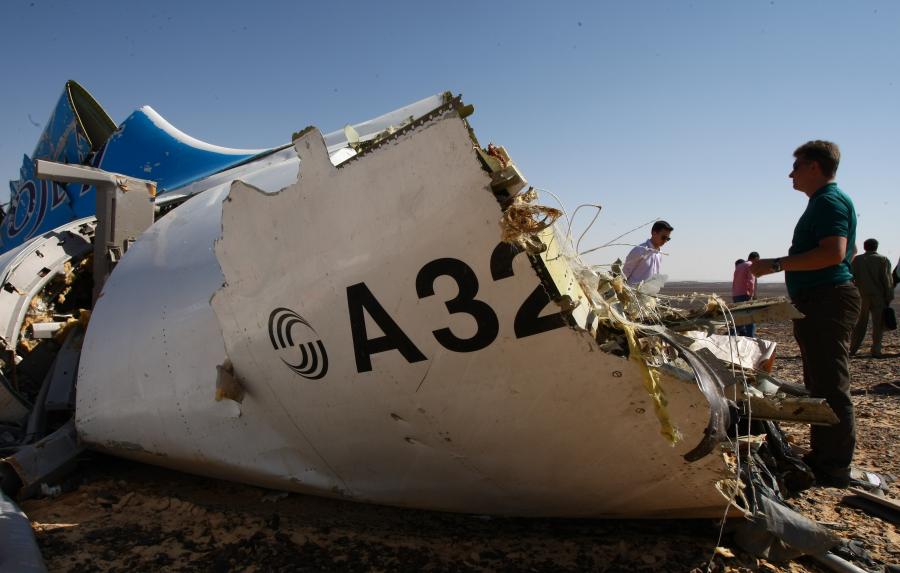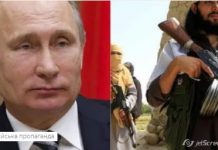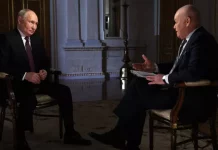
By now, it is pretty clear to the world that the tragic crash of Russia’s Airbus A321 in Egypt over two weeks ago resulted from a terrorist bomb. But if you think that is what Russians are being fed on domestic media, think again. The Kremlin has been hiding the actual cause of the catastrophe, just as it did with the downing of Malaysian Flight MH17. And it will most likely continue doing so, as long as it is possible.
Both A321 and MH17 plane crashes are a direct result of the Kremlin’s ill-conceived foreign policy: MH17 last year was downed by a Kremlin-supplied Buk missile controlled by pro-Russian separatists; A321 crash, based on available evidence, was most likely an ISIS-backed terrorist response to Russia’s bombing in Syria.
The Kremlin doesn’t want the Russians to link the crash of A321 passenger jet to Russian airstrikes in Syria, as this would suggest that the Russian people are to pay an overly high price for Putin’s international adventures and geopolitical ambitions. In fact, Putin’s spokesman Dmitry Peskov recently went as far as to warn against linking A321 crash to Russia’s operation in Syria due to the absence of “the slightest evidence indicating there was an act of terror”. One week later, Kremlin Chief of Staff, Sergei Ivanov, repeated the same statement almost verbatim. In an attempt to prevent Russians from drawing unfavourable conclusions about the Kremlin’s disastrous policy-making, Russian state media will likely keep hiding the real cause of the tragedy from their domestic audience by silencing, denying and faking the actual facts. Russia’s state media coverage of the MH17 incident serves a useful example of how the Kremlin usually executes such a deception.
The first step is silence and denial. The downing of MH17 was the main story on front pages of most newspapers worldwide hours following the disaster. Not so in Russia, where key newspapers ran frontline stories about side-topics (such as eating habits of Russians and US sanctions against Russia) while relegating coverage of MH17 to the back. Naturally, this made some observers suspect a deliberate plan to downplay an attack that the world was already linking to Russia. The A321 crash was followed by a similar silence in Russia. President Vladimir Putin’s first official comment with condolences to the victims only appeared three days (!) after the plane crash. Initially, Russian state-run media largely avoided focusing on the possibility of a bomb explosion. The first persuasive proof of bomb explosion came not from the Russian intelligence sources (despite it having full access to the investigation materials), but from UK and US intelligence. Until now, Russian state media remains hesitant to accept a bomb explosion as the main explanation of A321 catastrophe, despite an abundance of evidence. In contrast to the US and UK officials underlining strong indications of a bomb explosion, Russian officials keep stressing that no conclusive evidence in support of any theory exists and any speculation at this point is harmful.
The second step is filling the domestic information environment with multiple alternative theories of the crash, no matter how absurd. In the case of MH17, Russian media suggested that Ukrainian army missiles and/or a Ukrainian Su-25 fighter jet might have downed the plane, that Russian defense ministry spotted missile radar activity in Ukraine on the day of the tragedy, and that the Ukrainians might have mistaken MH17 for Vladimir Putin’s presidential jet. The ‘separatist’ leader at-the-time, Igor Strelkov-Girkin, probably won the creativity prize by suggesting that MH17 was flying with dead people aboard before it crashed. Pro-Kremlin agencies generated multiple badly faked pieces of evidence culminating with a poorly photoshopped picture of Ukrainian Su-25-fired missile approaching MH17, which was broadcasted on Russia’s major TV channel and then immediately discredited on the web.
Likewise, multiple alternative theories about flight A321 emerged: a number of publications stressed the poor technical condition of Airbus A321 as the primary cause of the crash, referencing non-existent suorces by foreign news agencies. Russian officials (including the head of RosAviation, Alexander Neradko) initially kept denying the possibility of a bomb explosion, and focused on the poor technical condition of the plane as the main working hypothesis. Russian media accused the west of deliberately using the tragedy to create domestic political problems for Putin, implementing a psychological attack against Russia, and pointed at potential CIA involvement in the plane crash. On November 8, Dmitry Kiselev, a leading pro-Putin pundit suggested on Russia’s top TV channel that Washington allowed ISIS to crash A321.
Because the Russian state media approach in its coverage of the A321 and MH17 plane crashes has been virtually identical so far, we can assume what happens next. Having distracted the Russian public with multiple alternative theories and conspiracies for a sufficiently long period of time, the pro-Kremlin media will slowly start accepting the terrorist bomb hypothesis. But they will use a slightly modified, rather than true, version of the story. In the case of MH17, after almost a year, pro-Kremlin media finally accepted that a Buk missile hit the plane. However, in the Kremlin’s version of the story, it was an older version of a Buk missile, which was only available to the Ukrainians and not the combined Russian/separatist militants.
Similarly, with flight A321, the Kremlin will likely keep delaying the official investigation, insisting that it is too early to draw conclusions, and come up with multiple conspiracies and fake theories. This is why the Kremlin keeps avoiding setting specific deadlines for completing the investigation of A321 crash: recently, Kremlin Chief of Staff, Sergei Ivanov, announced that the investigation is unlikely to be completed by the end of 2015. Ultimately the pro-Kremlin media is likely to slowly start accepting the terrorist attack version of events, but with some key modification of the narrative, while consistently denying its link to Russia’s engagement in Syria. They may stress the west’s involvement in the terrorist attack or discover a link between the Syrian and Ukrainian events to reinforce the Kremlin’s official line that ‘Color’ revolutions and ‘Arab Spring’ are a product of America’s information aggression. The point is to find somebody or something upon whom to shift the blame. Such an approach will also justify Russia’s continuing engagement in Syrian and Ukrainian conflicts.
One thing is certain – the Russian public is unlikely to learn the real cause of the plane crash in the near future.
By Maria Snegovaya, Intersection





